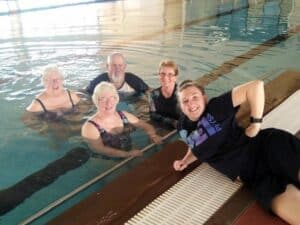As we age, come closer to retirement and pass retirement, our bodies undergo a slow decline in our physiological systems. Through this process, our levels of physical activity and exercise decrease to accommodate those physiological changes.
As adults, once we hit 35 years, our body’s ability to produce good quality cells and react to foreign bodies is slowly diminished and become inhibited. It takes longer for our bodies to produce cells that maintain bone health, skin/organ health and maintain brain function. This causes the degeneration process. Thus, our bodies require both a change in nutrition and a change in physical activity/exercise levels.
When asked about their activity levels, the older population generally respond with activities including gardening, household chores, shopping, etc. Some include walking, while most admit to not undergoing any structured exercises. While we appreciate that they are active throughout the day, there is a distinct difference between physical activity and exercise. Physical activity is defined as any bodily movement which causes a muscular contraction that increases energy expenditure. The examples previously mentioned are all examples of physical activity. Meanwhile, exercise can be defined as any planned, structured and repetitive activity designed to maintain or improve one or more components of physical fitness such as flexibility, strength, and co-ordination.
How much exercise should we be accomplishing? According to the national guidelines of exercise (Men et al., 2019), “For adults aged 18–64, the recommended minimum level of activity for health benefits is 150 minutes of moderate physical activity or 75 minutes of vigorous physical activity, or an equivalent combination of both, each week. For added health benefits this activity should be across 5 or more sessions each week. Adults are also encouraged to do muscle strengthening activities on at least 2 days a week. For adults aged 65 and over, the guidelines recommend at least 30 minutes of moderate physical activity on most, preferably all, days.”
The most common question asked is “Do we have to complete this exercise in one go or can we spread it out over the day?” The answer? No, you do not have to complete all your exercises in one go. Walking for example can be broken up into sections. It could be 3 lots of 10 minutes or 2 lots of 15 or even 6 lots of 5 minutes. The evidence shows that so long as you are working at a moderate intensity for all of the bouts, you will still gain the benefits of that exercise! This is perfect because we understand how busy life can be and how demanding jobs or other commitments can be. The message to gain from this is that even though you might do a little bit multiple times a day, EVERYTHING COUNTS!
References
Men, W., five, U., Children, T., healthy?, H., dementia?, C., & Health, W. (2019). Exercise Right for Life – How much exercise do you need?? – Exercise Right. Retrieved from https://exerciseright.com.au/exercise-right-for-life/




